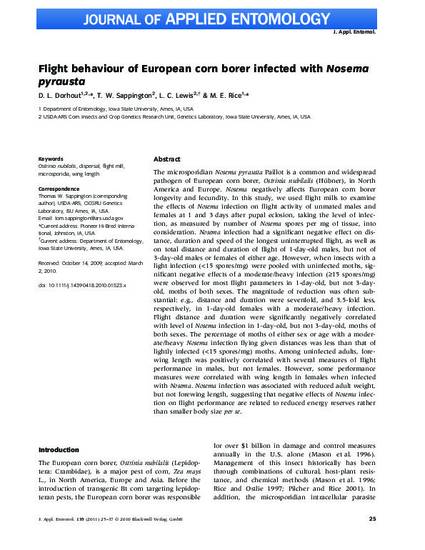
The microsporidian Nosema pyrausta Paillot is a common and widespread pathogen of European corn borer, Ostrinia nubilalis (Hübner), in North America and Europe. Nosema negatively affects European corn borer longevity and fecundity. In this study, we used flight mills to examine the effects of Nosema infection on flight activity of unmated males and females at 1 and 3 days after pupal eclosion, taking the level of infection, as measured by number of Nosema spores per mg of tissue, into consideration. Nosema infection had a significant negative effect on distance, duration and speed of the longest uninterrupted flight, as well as on total distance and duration of flight of 1-day-old males, but not of 3-day-old males or females of either age. However, when insects with a light infection (<15 spores/mg) were pooled with uninfected moths, significant negative effects of a moderate/heavy infection (≥15 spores/mg) were observed for most flight parameters in 1-day-old, but not 3-day-old, moths of both sexes. The magnitude of reduction was often substantial: e.g., distance and duration were sevenfold, and 3.5-fold less, respectively, in 1-day-old females with a moderate/heavy infection. Flight distance and duration were significantly negatively correlated with level of Nosema infection in 1-day-old, but not 3-day-old, moths of both sexes. The percentage of moths of either sex or age with a moderate/heavy Nosema infection flying given distances was less than that of lightly infected (<15 spores/mg) moths. Among uninfected adults, forewing length was positively correlated with several measures of flight performance in males, but not females. However, some performance measures were correlated with wing length in females when infected with Nosema. Nosema infection was associated with reduced adult weight, but not forewing length, suggesting that negative effects of Nosema infection on flight performance are related to reduced energy reserves rather than smaller body size per se.
Available at: http://works.bepress.com/thomas_sappington/75/

This article is from Journal of Applied Entomology 135 (2011): 25, doi:10.1111/j.1439-0418.2010.01523.x.